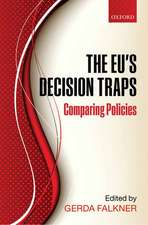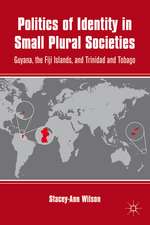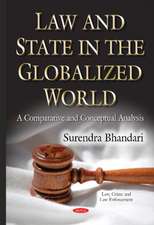Self-Determination & Constitution Making in Nepal: Constituent Assembly, Inclusion, & Ethnic Federalism
Autor Surendra Bhandarien Limba Engleză Hardback – 13 mai 2014
Chapters consider lessons to be drawn from the past and examine reasons for the abolition of monarchy in Nepal. The book highlights the major problems that the first elected Constituent Assembly (CA) faced in promulgating a new constitution, before it was dissolved in 2012.
The concept of right to self-determination and its complexities at the domestic level are all explored, along with ways forward to address the problem of constitutionalism, ethnic federalism and democracy. The author offers solutions as to how the second CA could address problems to promulgate a new constitution.
The book elaborates on the role that constitutionalism plays in constitution making and the survival of a constitution.
Scholars of politics and international studies, policy makers and those with an interest in law and constitution in Asia will all find this work of interest.
| Toate formatele și edițiile | Preț | Express |
|---|---|---|
| Paperback (1) | 639.59 lei 6-8 săpt. | |
| Springer Nature Singapore – 3 sep 2016 | 639.59 lei 6-8 săpt. | |
| Hardback (1) | 645.79 lei 6-8 săpt. | |
| Springer Nature Singapore – 13 mai 2014 | 645.79 lei 6-8 săpt. |
Preț: 645.79 lei
Preț vechi: 759.76 lei
-15% Nou
Puncte Express: 969
Preț estimativ în valută:
123.57€ • 129.48$ • 102.15£
123.57€ • 129.48$ • 102.15£
Carte tipărită la comandă
Livrare economică 11-25 aprilie
Preluare comenzi: 021 569.72.76
Specificații
ISBN-13: 9789812870049
ISBN-10: 9812870040
Pagini: 276
Ilustrații: XXIII, 252 p. 6 illus.
Dimensiuni: 155 x 235 x 20 mm
Greutate: 0.57 kg
Ediția:2014
Editura: Springer Nature Singapore
Colecția Springer
Locul publicării:Singapore, Singapore
ISBN-10: 9812870040
Pagini: 276
Ilustrații: XXIII, 252 p. 6 illus.
Dimensiuni: 155 x 235 x 20 mm
Greutate: 0.57 kg
Ediția:2014
Editura: Springer Nature Singapore
Colecția Springer
Locul publicării:Singapore, Singapore
Public țintă
ResearchCuprins
Dedication.- List of Tables and Charts- Preface.- Acronyms.- Chapter 1: The Landscape of Constitution Making in Nepal.- 1.1: Six Decades of Constitutional History.- 1.2: Pre-1990 Constitution Making Processes.- 1.3: The 1990 Constitution Making Process.- 1.4: Making of the Interim Constitution 2007.- 1.5: Lessons from Past Constitutions Making.- 1.5.1: Constitution Writing versus Constitution Making.- 1.5.2: Constitution versus Constitutionalism.- 1.5.3: Political Interests versus System Building.- 1.5.4: Power versus Authority.- 1.5.5: The Rule of Law versus Rule by Law.- 1.5.6: Legitimacy versus Political Ideology.- 1.5.7: Challenges of the Divided Society and the Constitution Making.- 1.5.8: From Uncertainty to Political Stability.- 1.6: Concluding Observations.- Chapter 2: Abolition of Monarchy.- 2.1 Background.- 2.2: The First Conflict: Conflict between Gorkha and other Principalities.- 2.3: The Second Conflict: Conflict between the Shah and Rana Dynasties.- 2.4: The Third Conflict: The King versus the People.- 2.4.1 Conflict between the King and the People from 1951 to 1990.- 2.4.2 Conflict from 1990 to 2008.- 2.5 Concluding Observations.- Chapter 3: Why did the Constituent Assembly Fail?.- 3.1: The Context of the CA.- 3.2: Reasons for the Failure of the CA.- 3.2.1: The Redundant Role of the CA.- 3.2.2: Faulty Discourse.- 3.2.3: Crisis of Constitutionalism.- 3.2.4: Democratic Deficit.- 3.3: Designing a Constitution in the Future.- 3.3.1: Political Consensus.- 3.3.2: From Ideology to Constitutionalism?.- 3.3.3: Civic or Citizenry Identity.- 3.3.4: Welfare-Grundnorm.- 3.4: Concluding Observations.- Chapter 4: Epistemology of Ethnic Federalism.- 4.1: Civic or Ethnic Federalism?.- 4.2: Ethnic & Indigenous Identity.- 4.3: Ethnic Federalism in Nepal.- 4.4: Major Schools of Thought & the Controversy.- 4.5: Civic Identity.- 4.5.1: Marxism.- 4.5.2: Max Weber & Ethnicity.- 4.5.3: Robert Park & Assimilation to Civic State.- 4.6: Concluding Observations.- Chapter 5: Nation-Building, Inclusion & Liberal Democracy.- 5.1: Nation-Building in Nepal.- 5.1.1: Formative Stage of Nation-Building.- 5.1.2: Democratic Stage of Nation-Building.- 5.1.3 Post-National Stage of Nation-Building.- 5.2 Inclusion.- 5.2.1 Inclusion During the Panchayati Era: 1960-1990.- 5.2.2 Inclusion in the Post-1990 Era.- 5.3: Liberal Democracy & Federalism.- 5.3.1 Constitutionalism.- 5.3.2 The Rule of Law.- 5.3.3 Political Parties Reform.- 5.3.4 A Robust Counter Hegemonic Mechanism in Place.- 5.4: Concluding Observations.- Chapter 6: Right to Self-Determination & Restructuring the Nepalese State.- 6.1 Right to Self Determination (RSD).- 6.2: RSD: Internal Autonomy of Groups & Ethnic Federalism.- 6.2.1: The UN Declaration on Indigenous Peoples.- 6.2.2: RSD & Minority Rights.- 6.3: IRSD & its Scope: Empowerment of All Peoples.- 6.3.1: The Scope of IRSD under the UNDRIP.- 6.3.2 Rights over Land and Resources.- 6.3.3: IRSD and Human Rights for All Peoples.- 6.4: Restructuring the Nepalese State.- 6.4.1: Could Federalism Ensure Autonomy?.- 6.4.2: Is Federalism the Solution of Discrimination and Inequality?.- 6.4.3 Is Federalism the Natural Political Course for Nepal?.- 6.5: Concluding Observations.- Chapter 7: Prospects of Liberal Democracy and Development.- 7.1: The CA Must Not Repeat Past Mistakes: Learn From the Past.- 7.1.1: Learn from the Past and Shun any Redundant Role.- 7.1.2: Build and Entrench Constitutionalism.- 7.1.3: Espouse a Robust and Transparent Discourse.- 7.1.4: Don’t Endure Democratic Deficit.- 7.2: Monarchy is Abolished: Monarchs Have Yet to be Abolished.- 7.2.1: Monarchs are still Predominant.- 7.2.2: Political Leaders are Acting Irresponsibly.- 7.3: Ethnic Federalism v. Federalism: Don’t Summon the Condition of Scylla & Charybdis.- 7.3.1 Methodological Issues.- 7.3.2: A Riddle of Positive Discrimination.- 7.3.3: More Rigid Boundaries.- 7.3.4: Federalization is not a One-time Job.- 7.3.5: AMisnomer of Minority Protection.- 7.3.6: A Pricey Institution.- 7.3.7: Possible Political Conundrum.- 7.4: Inclusive State: Within the Scope of Human Rights.- 7.4.1: Full Cultural Expression and Plurality.- 7.4.2: Four Major Objections.- 7.4.3: Welfare Policy for an Inclusive State.- 7.5: Civic State: From a Normative to a Positive State.- 7.5.1: Social Political Equilibrium.- 7.5.2: Constrain to Democratic Majoritarianism.- 7.5.3: It is not an Ethnic State.- 7.5.4: The Rights-Based Approach.- 7.6: Political Parties Reform: From Private Companies to Public Entities.- 7.6.1: Private Companies to Public Entities.- 7.6.2: Political Intolerance.- 7.6.3: Party Fetish.- 7.7: Liberal Democracy: Social Engineering of Inclusion, Participation, and State Restructuring.- 7.7.1: Challenges of Liberal Democracy.- 7.7.2: Consociational Democracy & Power-Sharing.- 7.7.3: Democracy as a Way of Life.- 7.8: Positive Discrimination: Revisiting the Rawlsian Model.- 7.8.1: Justice as Fairness.- 7.8.2: The Political Conception of Justice.- 7.8.3: Managing Inequality.- 7.8.4: What is to be done?.- 7.9: The Rule of Law: From Constitutionalism to Post-Constitutionalism.- 7.9.1: A Positive Order.- 7.9.2: Constitutional to Post-Constitutional Order.- 7.10: Freedom and Development: B. P. Koirala & Amartya Sen Revisited.- 7.10.1: Human Face of Development.- 7.10.2: Unfreedoms and Remediable Injustices.- 7.10.3: B. P. Koirala.- 7.11: Policy Choices: Welfare-Grundnorm.- 7.11.1: Fairness, Efficiency, and Validity.- 7.11.2: Hierarchy and Grundnorm.- Chapter 8: Concluding Observations.- Bibliography.
Notă biografică
Dr Surendra Bhandari's research interests include the perspectives of legal theory, WTO rules making and constitutionalism. His area of work examines how normative concepts are transmuted into a positive legal structure. Connected by his methodology of welfare-grundnorm (WG), these perspectives inquire how legitimacy, authority and validity interplay both at domestic and international rules making. Predominantly in the domain of legal theory, his research explains the legal osmosis process of the constitutionalization of international laws and its implications for the domestic legal systems, with the WTO as a case in point. In the domain of constitutionalism, his inquiry mirrors the formative process of constitutionalism, its ownership, and implications for governance, taking Nepal as a point of reference. As a Governing Board Member of the Foundation for Development of International Law in Asia (DILA), he is also engaged in the study of the Asian approaches to international law.
Textul de pe ultima copertă
This book systematically analyzes why constitutions do not survive in Nepal, despite sixty years of constitutional history. The author discusses the epistemology of ethnic federalism in Nepal and examines the challenges of nation building and post-nation constitutionalism. The work addresses the connection between ethnic identity, right to self-determination, constitution making and state restructuring, offering possible ways forward for Nepal.
Chapters consider lessons to be drawn from the past and examine reasons for the abolition of monarchy in Nepal. The book highlights the major problems that the first elected Constituent Assembly (CA) faced in promulgating a new constitution, before it was dissolved in 2012.
The concept of right to self-determination and its complexities at the domestic level are all explored, along with ways forward to address the problem of constitutionalism, ethnic federalism, and democracy. The author offers solutions as to how the second CA could address problems to promulgate a new constitution.
The book elaborates on the role that constitutionalism plays in constitution making and the survival of a constitution.
Scholars of politics and international studies, policy makers and those with an interest in law and constitution in Asia will all find this work of interest.
Chapters consider lessons to be drawn from the past and examine reasons for the abolition of monarchy in Nepal. The book highlights the major problems that the first elected Constituent Assembly (CA) faced in promulgating a new constitution, before it was dissolved in 2012.
The concept of right to self-determination and its complexities at the domestic level are all explored, along with ways forward to address the problem of constitutionalism, ethnic federalism, and democracy. The author offers solutions as to how the second CA could address problems to promulgate a new constitution.
The book elaborates on the role that constitutionalism plays in constitution making and the survival of a constitution.
Scholars of politics and international studies, policy makers and those with an interest in law and constitution in Asia will all find this work of interest.
Caracteristici
Highlights the reasons for the failure of the Constituent Assembly in Nepal Presents insights into managing the tension between constitutionalism and constitution making in Nepal Offers epistemology of ethnic federalism in Nepal Provides solutions for Nepal's constitutional future Includes supplementary material: sn.pub/extras














